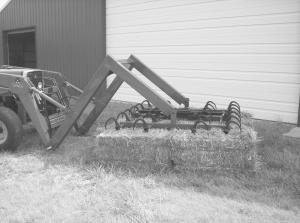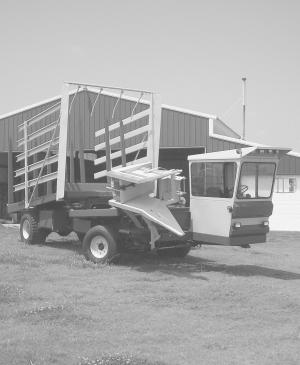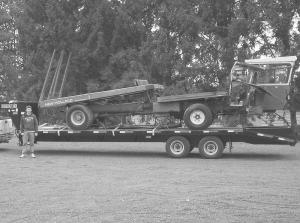2008 - Volume #32, Issue #6, Page #32
[ Sample Stories From This Issue | List of All Stories In This Issue | Print this story
| Read this issue]
"Like New" Rebuilt SP Bale Wagon
 |
 |
 |
The two men operate a custom baling business in which they sell small square bales, mostly to the horse market. "Much of the original wagon was worn out so bad there was almost nothing left. There were a lot of parts that we couldn't buy from New Holland so we had to make them ourselves. Now it looks much like a modern bale wagon," says Wilson, of Glenpoll, Oklahoma. "We spent a total of about $10,000, including the $2,400 purchase price."
They went online to find the self-propelled New Holland 1048 bale wagon, which was equipped with a cab and bale pickup on front and powered by a 361 cu. in. Ford V-8. engine. The seller wanted to part the wagon out, but Wilson offered to buy the entire machine. He then drove to Moses Lake, Wash., and hauled the wagon home on a trailer behind his pickup. The two men worked on the wagon all winter and finished rebuilding it last June.
The bale pickup was almost completely worn out. "We spent three weeks grinding and rebuilding the pickup's frame and another week rebuilding the mouth where the bale pickup attaches to the wagon," says Wilson.
The arms that raise and lower the pickup were broken so they rebuilt them. "The arms have to be exactly located and their pivot angle has to be perfect, so it took quite a while to get all the geometry just right," says Wilson.
They also welded up all the cracks in the cab and repainted it. And they rebuilt the engine.
The wagon was originally equipped with thin plywood sides which were replaced with horizontal lengths of 2 by 6-in. channel iron. They built a new tine arch at the front end of the wagon that keeps bales from falling forward off the wagon once it's full.
A rolling rack with steel tines is used to group 12 bales together and then roll them to the back of the wagon. The rack was originally controlled by a spring and cable return system but it was worn out, so they replaced the system with a 6-ft. long hydraulic cylinder.
The radiator was originally mounted between the cab and pickup where the screen could easily get clogged up with hay and grass. The radiator fan was shaft-driven and didn't do a good job of cooling the engine, so they replaced it with a radiator off a Ford F-350 pickup. They moved the radiator to one side of the wagon on back, where the fuel tank was originally mounted. They also mounted an electric fan to provide better cooling. "The electric fan always runs at full speed, whether the engine is idling or going at full throttle," says Wilson.
They moved the fuel tank to the opposite side of the wagon, just ahead of the rear wheel.
The wagon's hydraulic system was still in good shape. However, every moving part and every bearing on it was worn out, says Wilson. "We had to make our own bearings and bushings for all the pivot points on the table and pickup. There were a lot of parts that we couldn't buy from New Holland."
The wagon's flatbed is designed to tilt down to the ground and has four big tines on back. A push-off foot is used to push the bales back off the tines.
They stack the bales outside a barn and later use a home-built, loader-mounted bale clamp to move them into the barn. It grabs 12 bales at a time and can stack them up to 14 ft. high. "We need a small tractor to get into the barn, but all the commercial bale clamps were too heavy for our Massey Ferguson 243 50 hp tractor," says Wilson. "The entire clamp weighs only about 350 lbs. It's the same size as commercical bale clamps but weighs a lot less."
The clamp's arms are made from 2 by 6, 14-ga. C-channel, welded together to make a 4-sided tube. "It's real thin, but it's very strong," says Wilson. The bale clamp arms pin onto the loader arms. A single cylinder is connected to four shafts that make all the hooks turn together at the same time. Two more cylinders are used to pivot the arms.
"We spent about $1,200 to build the clamp. Commercial ones sell for about $4,000," notes Wilson.
Contact: FARM SHOW Followup, Stuart Wilson, 16701 S. 33rd West Ave., Glenpoll, Okla. 74033 (ph 918 519-3267; blueskyoklahoma@yahoo.com).

Click here to download page story appeared in.

Click here to read entire issue
To read the rest of this story, download this issue below or click here to register with your account number.




